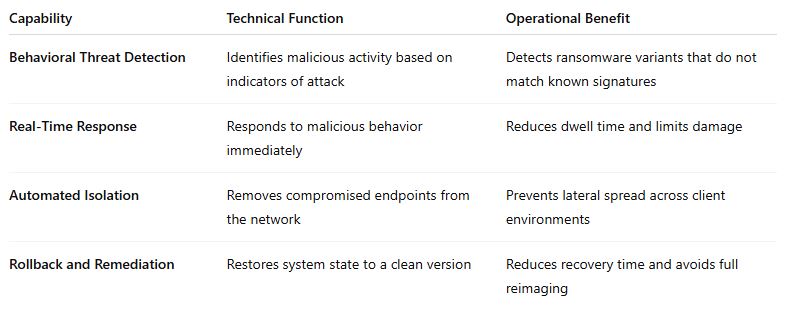Join the Level Discord — connect with IT professionals, share ideas, and get real-time updates
Check it outSecurity
Modern endpoint security requires more than traditional antivirus, especially as ransomware and fileless threats increasingly target SMBs. EDR and XDR solutions provide behavioral detection, automated isolation, and fast incident response, particularly when combined with an RMM platform for operational control.

Modern endpoint security for MSPs must account for more than malware signatures or known virus patterns. Attackers frequently use fileless malware, credential compromise, living-off-the-land binaries (LOLBins), and lateral movement techniques that traditional antivirus cannot detect. This is where EDR (Endpoint Detection and Response) and XDR (Extended Detection and Response) become essential components of a modern security stack.
Small and mid-sized businesses are now primary ransomware targets. They often lack:
Traditional antivirus relies on static signatures, meaning it only detects known malware. Modern ransomware variants are polymorphic, meaning each execution can change its characteristics to evade conventional detection. This is one of the main reasons endpoint security for MSPs now standardizes around EDR and XDR.

EDR is designed to recognize malicious behavior, such as:
XDR expands this by correlating telemetry across multiple layers, enabling detection of coordinated or multi-stage attacks.

Without EDR:
Ransomware executes, encrypts local and network data, and spreads before detection. The MSP is alerted only after systems are unavailable.
With EDR/XDR:
Anomalous encryption behavior triggers automated isolation. The system alerts the MSP, rolls back affected files, and prevents lateral movement.
Outcome:
Containment before operational disruption.

RMM platforms maintain operational integrity.
EDR/XDR platforms maintain security integrity.
When integrated:
This forms a closed-loop response system.
Vendor
Strengths
Considerations
Microsoft Defender for Endpoint / XDR
Strong identity integration via Entra ID
Licensing complexity
CrowdStrike Falcon Insight
Lightweight agent and strong threat intelligence
Higher pricing tiers
SentinelOne Singularity
Automated rollback and strong behavioral analytics
Integration validation needed
Palo Alto Cortex XDR
Unified endpoint, network, and cloud signal correlation
Requires higher operational maturity
Trend Micro Vision One
Broad endpoint and email security coverage
Requires tuning to reduce alert noise
What is EDR in cybersecurity?
EDR detects and responds to malicious activity at the endpoint using behavioral analysis and real-time containment.
How is XDR different from EDR?
XDR correlates telemetry across identity, email, cloud, and network layers to detect multi-step attacks that EDR alone may not see.
Can EDR/XDR replace an RMM platform?
No. RMM handles management and automation. EDR/XDR handles detection and response. They are complementary.
Modern endpoint security requires more than signature-based antivirus tools. MSPs must detect and respond to threats as they occur, especially as ransomware campaigns continue to target SMB organizations. EDR and XDR provide the behavioral analysis, automated containment, and response workflows necessary to prevent large-scale compromise.
When combined with an RMM platform:
For MSPs modernizing their service offering, RMM plus EDR/XDR is now the standard architecture for endpoint security and operational efficiency.
At Level, we understand the modern challenges faced by IT professionals. That's why we've crafted a robust, browser-based Remote Monitoring and Management (RMM) platform that's as flexible as it is secure. Whether your team operates on Windows, Mac, or Linux, Level equips you with the tools to manage, monitor, and control your company's devices seamlessly from anywhere.
Ready to revolutionize how your IT team works? Experience the power of managing a thousand devices as effortlessly as one. Start with Level today—sign up for a free trial or book a demo to see Level in action.